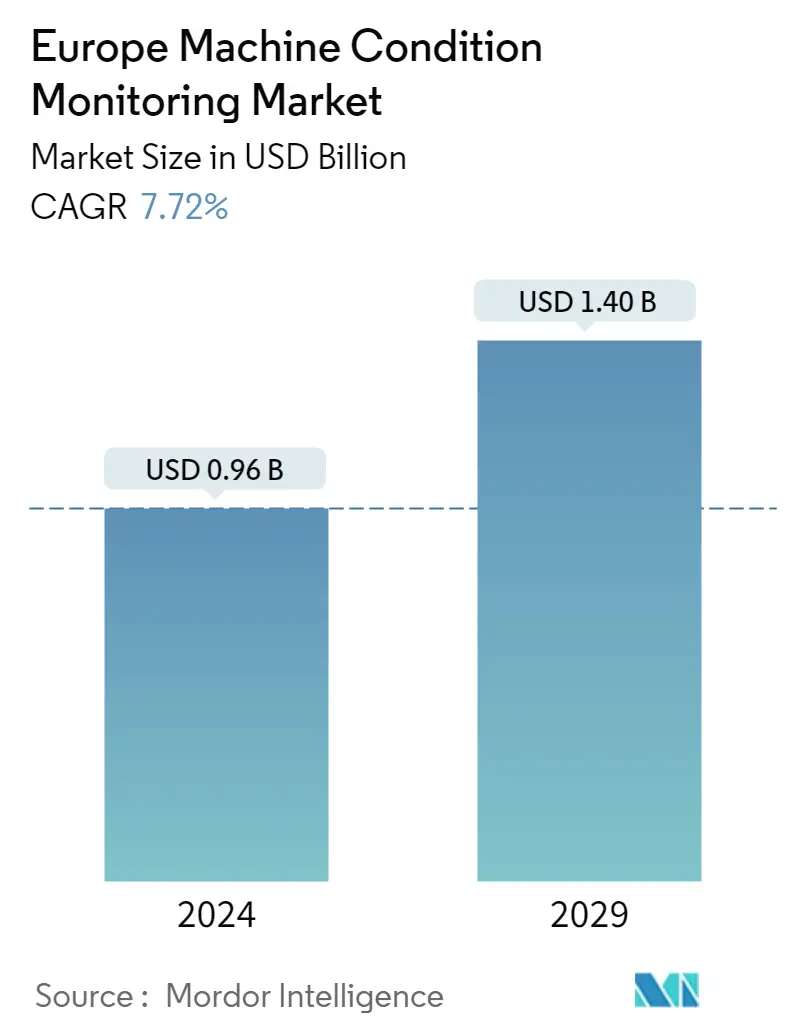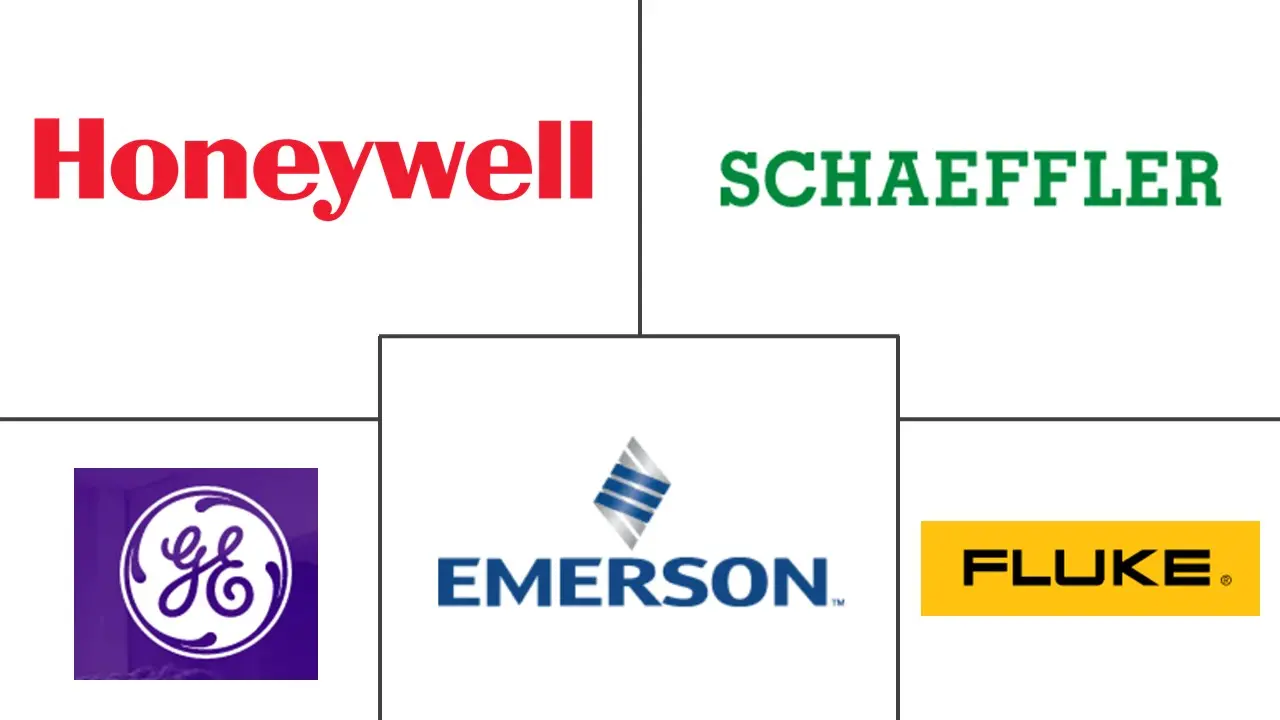Market Size of Europe Machine Condition Monitoring Industry

| Study Period | 2019 - 2029 |
| Base Year For Estimation | 2023 |
| Market Size (2024) | USD 0.96 Billion |
| Market Size (2029) | USD 1.40 Billion |
| CAGR (2024 - 2029) | 7.72 % |
| Market Concentration | Medium |
Major Players
*Disclaimer: Major Players sorted in no particular order |
Europe Machine Condition Monitoring Market Analysis
The Europe Machine Condition Monitoring Market size is estimated at USD 0.96 billion in 2024, and is expected to reach USD 1.40 billion by 2029, growing at a CAGR of 7.72% during the forecast period (2024-2029).
An outlook toward low-cost mass production has led maintenance professionals to turn to condition monitoring. With active machine condition monitoring, multiple industries can prevent machine failures, which is an added capital investment.
- One of the primary goals of any business is to prolong an asset's lifecycle and ensure that the asset functions efficiently for an extended period. This can be accomplished through the use of condition monitoring. Maintenance is crucial to machines. Machine condition monitoring is an important part of maintenance, and thus, many companies have been focusing more on asset utilization and increasing productivity.
- Predictive maintenance systems can help organizations with condition-monitoring tools to track the performance of any equipment or machine in idle, normal, and peak performances. The data from machines operating at different conditions helps plan maintenance in the future to prevent sudden failure or downtime.
- Automated machine monitoring forms the first step toward achieving smart factories. In a smart factory, machines are interconnected with IoT-enabled, web-based sensors that facilitate real-time machine data extraction. The network of connected machines helps obtain valuable insights into machine performance, enhances ongoing production, and analyzes estimated versus actual production ratios.
- The rise of smart manufacturing and Industry 4.0 increased the possibility of monitoring the condition of the production equipment in a factory. Physical sensors can be deployed to collect data from the factory floor, and they can be processed and visualized on a dashboard on a workstation. This provides an overview of the condition of the machines and enables increased uptime and efficiency.
- All European businesses have crucial assets for manufacturing goods and services offering revenue, experiencing a rapid decline due to the COVID-19 pandemic. The management of such companies has been feeling extreme urgency and panic, increasing the emphasis on cutting costs. Since manufacturing activity is low, companies are tempted to eliminate maintenance, which can result in high costs during the forecast period.
Europe Machine Condition Monitoring Industry Segmentation
Machine condition monitoring is the process of monitoring the condition of a machine with the intent of predicting mechanical wear and failure.
The market is segmented by type (hardware (vibration condition monitoring equipment, thermography equipment, lubricating oil analysis), software, services), end-user vertical (oil and gas, power generation, process and manufacturing, aerospace and defense, automotive and transportation, other end-user verticals), and country (United Kingdom, Germany, France, Italy, Rest of Europe). The market sizes and forecasts are provided in terms of value in USD million for all the above segments.
| By Type | |||||
| |||||
| Software | |||||
| Services |
| By End-user Vertical | |
| Oil and Gas | |
| Power Generation | |
| Process and Manufacturing | |
| Aerospace and Defense | |
| Automotive and Transportation | |
| Other End-user Verticals (marine, Mining, Metal, Etc.) |
| By Country | |
| United Kingdom | |
| Germany | |
| France | |
| Italy | |
| Rest of Europe (Eastern Europe and Western European Countries) |
Europe Machine Condition Monitoring Market Size Summary
The European machine condition monitoring market is poised for significant growth, driven by the increasing adoption of predictive maintenance systems and the rise of smart manufacturing initiatives under Industry 4.0. This market is characterized by the integration of advanced technologies such as IoT, cloud computing, and AI, which facilitate real-time monitoring and data analysis of machinery. These technologies enable businesses to extend the lifecycle of their assets, enhance productivity, and reduce unplanned downtime by providing insights into machine performance and health. The shift towards automated and interconnected systems is a crucial step towards achieving smart factories, where machines are equipped with IoT-enabled sensors that offer valuable data for optimizing production processes.
The market landscape in Europe is moderately fragmented, with key players like Honeywell International Inc., Schaeffler Technologies AG & Co. KG, General Electric Company, Emerson Electric Co., and Fluke Corporation leading the charge. These companies are actively engaging in strategic partnerships, innovations, and acquisitions to strengthen their market position and expand their product offerings. The automotive and maritime industries, particularly in Germany, are significant contributors to the demand for condition monitoring solutions, driven by the need to ensure operational efficiency and safety. As businesses continue to prioritize cost-effective maintenance strategies, the market is expected to witness sustained growth, with condition monitoring becoming an integral part of industrial operations across Europe.
Europe Machine Condition Monitoring Market Size - Table of Contents
-
1. MARKET INSIGHTS
-
1.1 Market Overview
-
1.2 Industry Attractiveness - Porter's Five Forces Analysis
-
1.2.1 Bargaining Power of Suppliers
-
1.2.2 Bargaining Power of Buyers
-
1.2.3 Threat of New Entrants
-
1.2.4 Threat of Substitutes
-
1.2.5 Intensity of Competitive Rivalry
-
-
1.3 Assessment of the Impact of COVID-19 on the Market
-
-
2. MARKET SEGMENTATION
-
2.1 By Type
-
2.1.1 Hardware
-
2.1.1.1 Vibration Condition Monitoring Equipment
-
2.1.1.2 Thermography Equipment
-
2.1.1.3 Lubricating Oil Analysis
-
-
2.1.2 Software
-
2.1.3 Services
-
-
2.2 By End-user Vertical
-
2.2.1 Oil and Gas
-
2.2.2 Power Generation
-
2.2.3 Process and Manufacturing
-
2.2.4 Aerospace and Defense
-
2.2.5 Automotive and Transportation
-
2.2.6 Other End-user Verticals (marine, Mining, Metal, Etc.)
-
-
2.3 By Country
-
2.3.1 United Kingdom
-
2.3.2 Germany
-
2.3.3 France
-
2.3.4 Italy
-
2.3.5 Rest of Europe (Eastern Europe and Western European Countries)
-
-
Europe Machine Condition Monitoring Market Size FAQs
How big is the Europe Machine Condition Monitoring Market?
The Europe Machine Condition Monitoring Market size is expected to reach USD 0.96 billion in 2024 and grow at a CAGR of 7.72% to reach USD 1.40 billion by 2029.
What is the current Europe Machine Condition Monitoring Market size?
In 2024, the Europe Machine Condition Monitoring Market size is expected to reach USD 0.96 billion.

